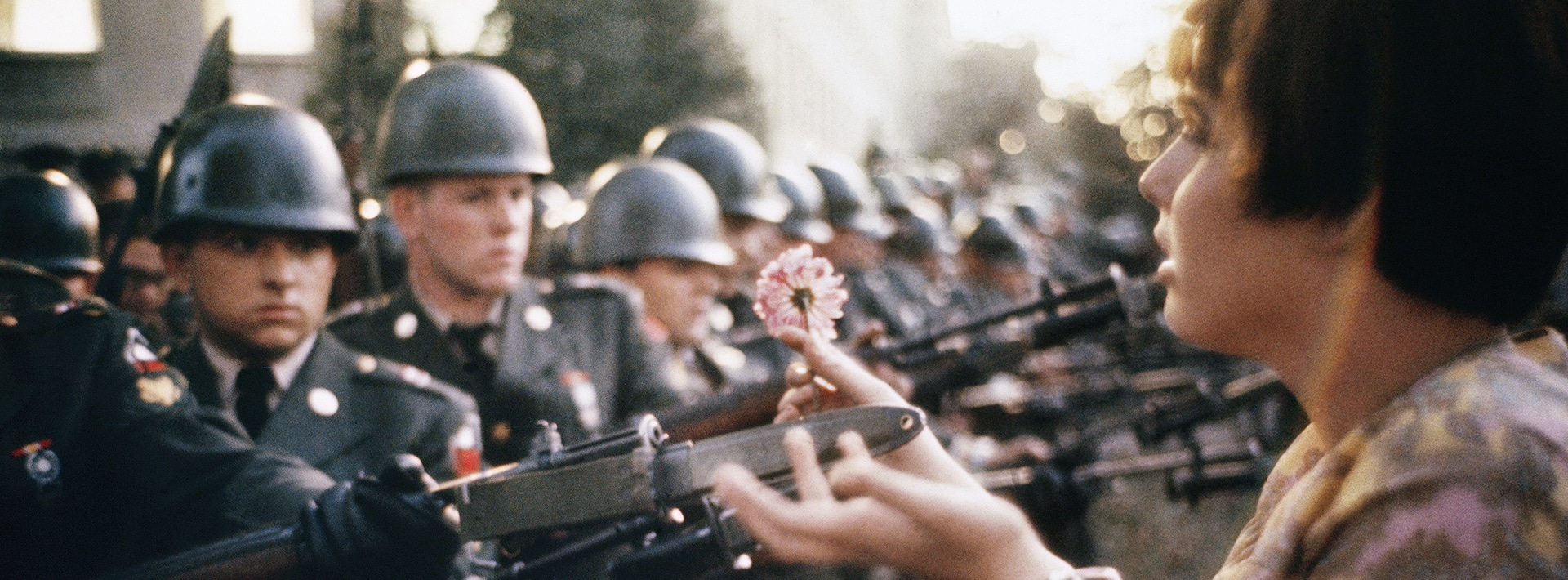
If we were to keep only one of Marc Riboud’s images, it would have to be this stand-off between soldiers pointing their bayonet rifles and a young woman handing them a flower. The year was 1967 in Washington, D.C., the country was bogged down by the Vietnam War, and American youth were calling for an end to the fighting. A kind of visual counterpart to their slogan “Make love, not war,” this image is iconic, whether in its black and white or color version–the latter only found by the photographer forty years after he took it.
For indeed, Marc Riboud primarily shot in black and white, as can be seen in the Musée Guimet exhibition and catalogue, to which the reporter left a large part of his work, comprising more than 50,000 photographs (negatives, slides and proofs on paper).

A sign from fate
Marc Riboud came to photography a little later in life, at almost thirty years old, in the early 1950s. A product of the upper-middle class in Lyon, he studied engineering and began working before giving up everything to devote himself to photography. For the man who had always been the most timid of the siblings, this was less an act of rebellion than a desire to grow and expand his horizons. He didn’t choose photography by chance. His father gave him his first camera–a Vest-Pocket he had used in the trenches of World War I–when he was 13 years old. A symbolic gift…

Throughout his career, Marc Riboud looked at the world through a kindly gaze, recording both the events and the atmosphere of his time. “I photograph like a musician sings. Watching is a breath and, when fortune smiles upon me and a good photo is given to me, happiness is not far away,” he once explained. As a teenager, he became involved in the French Resistance, an experience that forged his vision of man and of the human condition. The first image that brought him some attention was the perfect illustration of that: “The painter of the Eiffel Tower” (1953), another iconic image published in LIFE Magazine.
One year earlier, he had met Henri Cartier-Bresson and Robert Capa, two of the photographers that founded Magnum in 1947. They invited him to join their already famous photo agency. At the time, the agency was unique in that it fought for the status of author for photographers, whom Magnum viewed as the copyright owners of their images, and not the publishers, as was the rule back then. Above all, Magnum Photos established the notion that photographers should have the freedom to choose their subjects. And this is exactly how Marc Riboud would pursue his career.

From one country to another
At that time, photojournalism was synonymous with long journeys and an altruistic, if not humanist, approach. Indeed, Marc Riboud belonged to that generation that captured lands that were foreign and inaccessible to ordinary people. For it was through the illustrated press that people discovered the world then, as television was only in its infancy and taking airplanes was uncommon.

In those years, being a photojournalist also rhymed with adventure. And thus, from 1955 to 1958, Marc Riboud was on the road. He traveled across the Middle East, then spent a year in India before traveling to China for a stay of several months that ended in Indonesia and Japan. For each of these countries, he bore witness to their culture and way of life by photographing the people, the streets, the customs, the religious practices, without ever succumbing to gratuitous exoticism and always with respect for others.
Over the following decade, he went from a “wandering photographer” to a witness to the tumultuous events of history. In 1962, he was in Algeria for the independence celebrations; in 1968-1969, in war-torn Vietnam, where, in search of objectivity, he traveled to both the South and the North. In 1971, he covered the Indo-Pakistani conflict and in 1979 the Islamic revolution in Iran. In the 1980s, he witnessed the Solidarnosc resistance in Soviet Poland. “My eyes and my lens would sometimes close shut in the face of the violence,” he noted in the preface to the photography book Photo Poche No. 37, devoted to his work. A testament to his altruism and his sensitivity. For Marc Riboud always took his time, more interested as he was in the atmosphere of a place than in sensationalism or the money shot… And so, after heading up Magnum from 1974 to 1976, he decided to leave the agency in 1979, as he wasn’t a proponent of the spirit of competition.


Among all the countries he photographed, China held a special place in his heart. This is evidenced by numerous works, including Chines, published last year by La Martinière editions. Marc Riboud visited the country regularly up until 2010, when the Shanghai Museum of Fine Arts devoted an exhibition to his work. Six years before he passed away, at 93, he had photographed his favorite country one last time.
Sophie Bernard
Sophie Bernard is a journalist specializing in photography, a contributor to La Gazette de Drouot and Le Quotidien de l’Art, a curator, and a teacher at EFET in Paris.

Marc Riboud, Histoires possibles, Published by MNAAG / RMN-GP, 272 pages, 35 €. Available here.
Retrospective “Marc Riboud, Histoires possibles”, Musée national des arts asiatiques-Guimet (Guimet Museum). Until September 6, 2021. More information here.


